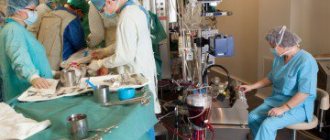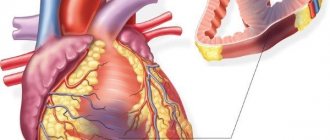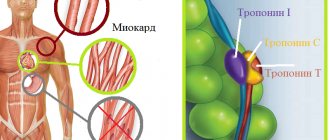Causes and treatment of scars on the heart
When a person develops a myocardial infarction, blood flow in one or more coronary vessels is disrupted. This leads to an imbalance between the need of myocardiocytes for oxygen and its supply. Changes in metabolism due to lack of nutrients aggravate the condition of the affected tissue. As a result, cardiac muscle cells begin to necrotize and die. In place of the dead tissue, a scar forms. In this article I want to talk about the mechanism and possible consequences of such a “replacement”.
Causes
What is a scar? In most cases, it occurs as a result of a heart attack and is characterized by a high content of fibrous elements. The entry of a blood clot or atherosclerotic plaque into the lumen of the coronary vessels leads to a sharp disruption of the blood supply to the heart, and as a result, to other organs.
After a myocardial infarction, the area of dead heart tissue becomes scarred, and this condition is called post-infarction cardiosclerosis.
Ischemia with scar formation occurs against the background of:
- coronary thrombosis associated with blood hypercoagulation;
- attacks of unstable angina with spasm of the coronary arteries;
- embolism (appearance of foreign particles in the lumen of the vessel);
- old age, when muscle fibers wear out;
- the appearance of atherosclerotic plaques in the bloodstream and subsequent blockage of the coronary vessels.
Muscle fibers are very sensitive to lack of oxygen, due to which their rapid necrosis occurs. After a heart attack, pain begins to fade. An area that has succumbed to necrosis becomes insensitive to pain.
The causes of cardiosclerosis following a heart attack include the following diseases of the circulatory system:
- myocarditis (diffuse inflammation of the heart muscle);
- connective tissue diseases (for example, rheumatism);
- frequent attacks of angina pectoris (accompanied by impaired blood flow and the appearance of persistent ischemia);
- acute and chronic heart failure.
A dangerous condition is myocardial dystrophy, in which muscle tissue becomes thin and weak. It leads to disruption of organ trophism, oxygen starvation, and chronic weakness. A lack of nutrients in the diet, especially Potassium, Calcium and Magnesium, negatively affects the condition of the circulatory system.
In the presence of scars, a vital organ for a person cannot work at full capacity, as a result of which the patient feels general malaise and other discomfort
The following conditions are considered risk factors:
- viral and bacterial infections (pneumonia, septic endocarditis, syphilis);
- diseases of the endocrine system (diabetes mellitus, thyrotoxicosis, obesity);
- anemia (low hemoglobin or red blood cells in the blood leads to impaired trophism of various organs);
- hard physical labor, playing sports without a break;
- hemosiderosis (accumulation of iron in muscle fibers);
- amyloidosis (formation of pathological protein – amyloid) in muscle fibers.
Excessive consumption of tonics can cause overstrain of the myocardium, which leads to disruption of the heart rhythm and the appearance of chronic hypoxia of various organs. Cardiosclerosis can also occur against the background of a hereditary predisposition.
Development mechanism
At the time of the development of an acute infarction, a sharp disruption of the blood supply to the myocardium occurs for the following reasons:
- Rupture of an atherosclerotic plaque under the influence of a sharp jump in pressure, increased heart rate and acceleration, and accelerated blood flow through the coronary vessels.
- Blockage of blood vessels due to blood thickening (acceleration of platelet aggregation, activation of the coagulation system, decreased rate of blood clot lysis).
- Spasm of the coronary artery (vasoconstriction).
I often observed patients in whom several factors were identified as the cause of the disease with myocardial damage. In young patients, vasospasm is often the basis of pathological disorders, which is not possible to determine after the start of treatment.
Varieties
Cardiosclerosis has several different classifications. There are two types of pathology based on the prevalence of the heart muscle lesion:
- Focal cardiosclerosis. Scars are formed separately - both small and large in area. Most often occurs after myocardial infarction or myocarditis. Large-focal cardiosclerosis looks like the appearance of massive healed fields, when the entire wall of the heart can be replaced by connective tissue - this is how a chronic aneurysm occurs. Finely focal cardiosclerosis has small, chaotically located scars in the thickness of the myocardium.
- Diffuse form of cardiosclerosis. Evenly distributed connective tissue throughout the heart. Occurs during chronic ischemia.
The second type of classification is based on the cause of the disease.
- Post-infarction cardiosclerosis. Foci of connective tissue in the myocardium that arise after a heart attack. Due to the inability of heart cells to reproduce, dead muscle fibers are replaced by scars. In the absence of treatment, repeated infarctions occur, the lesions grow and unite into entire scar fields. The body, trying to compensate for the efficiency of the heart, increases muscle volume, which leads to myocardial hypertrophy. After depletion of resources, dilatation occurs - expansion of the heart cavities. Occurring due to severe scarring, an aneurysm (protrusion of the wall of the left cardiac ventricle) leads to heart failure and deterioration of blood flow in all body systems.
- Atherosclerotic cardiosclerosis. Chronic ischemia leads to narrowing of the lumens of blood vessels - atherosclerosis. The process occurs slowly over a long time due to a lack of oxygen in the tissues. This type is distinguished by the diffuse nature of the scars; if left untreated, heart defects may occur.
- Postmyocardial cardiosclerosis. More often in young patients, inflammatory processes in the myocardium are detected due to past infectious diseases and allergies. The entire thickness of the heart muscle is affected.
- Congenital cardiosclerosis. A rare form of the disease due to disorders in the cardiovascular system.
Expert advice
I strongly recommend starting treatment in a hospital immediately after an acute attack, since only in this case is it possible to limit the further spread of necrosis and minimize irreversible changes in the myocardium.
The study of histological samples confirms the destruction of the cardiac myocyte 20 minutes after the development of ischemia. After 2-3 hours of lack of oxygen, their glycogen reserves are depleted, which marks their irreversible death. Replacement of myocarditis with granulation tissue occurs within 1-2 months.
As my practice and the observations of colleagues show, the scar on the heart is finally consolidated after six months from the moment the first symptoms of acute infarction appear and is a section of coarse collagen fibers.
Clinical manifestations
Symptoms and their severity directly depend on what disease caused the damage to muscle tissue. Cardiologists say that scars on the heart after a heart attack (a photo of the affected organ is shown schematically below) can form over several years. In this case, the process is often asymptomatic.
The absence of clinical manifestations is due to the fact that the organ manages to maintain contractility and compensate for the volume of normal tissue. When it is no longer able to function fully, the following symptoms appear:
- Painful sensations in the chest.
- Severe shortness of breath.
- Swelling of the face and limbs.
- Severe fatigue even after minor physical exertion.
- Increased degree of fatigue.
Over time, the fingertips on both the upper and lower extremities acquire a bluish tint. This is a specific sign of severe heart failure. At this stage, doctors take measures to prevent further damage to the heart. Often the only way to save the patient's life is surgery.
Classification
Heart scars can be classified according to their location and extent of distribution.
They can be located along the coronary vessels:
- Impairment of blood flow in the anterior interventricular artery leads to ischemia with the subsequent appearance of a scar in the area of the septum between the ventricles, involving the papillae and lateral wall, as well as on the anterior surface and apex of the left ventricle.
- The infero-posterior and lateral part is affected when the left circumflex coronary artery is blocked.
- Problems with the blood supply to the myocardium in the right artery results in irreversible changes in the right ventricle and can affect the posterior inferior part of the left ventricle and the septum. But such a violation is extremely rare.
According to the type of distribution, scars can be local (focal), which can be compared to a scar on the body, or diffuse (multiple). Experts call the second option dystrophic changes in the myocardium.
Surgical care for scars
Surgery is indicated only in emergency situations, when the patient is in critical condition and drug therapy is powerless. The following types of operations are carried out:
- Shunting. It consists in expanding the lumen of the coronary vessels.
- Heart transplant. Performed on patients under 65 years of age.
- Removal of the aneurysm. Under general anesthesia, a protruded area of one of the walls of the left or right ventricle is excised.
The scar after surgery heals quite quickly and rarely causes severe discomfort to the patient. After the rehabilitation period, the patient can return to a normal lifestyle, but with mandatory adherence to a special diet and further drug therapy.
How does a scar manifest itself?
The acute period of a heart attack is characterized by a variety of clinical manifestations. The main symptom is pain, which can be relieved exclusively with narcotic analgesics and can be observed from an hour to 2-3 days. Then the pain syndrome disappears and the formation of an area of necrosis begins, which takes another 2-3 days. Then comes a period of replacing the affected area with loose connective tissue fibers.
If the correct treatment tactics are used, the following symptoms are noted:
- development of compensatory hypertrophy;
- rhythm disturbance (which often accompanies the acute period) is eliminated;
- tolerance to stress gradually increases.
If a scar that appears on the heart crosses the conduction paths along which the impulse travels, a conduction disorder is recorded, such as a complete or partial blockade.
In the case of successful recovery after a primary small-focal infarction, I did not notice any significant disturbances associated with the functioning of the heart in my patients.
If patients have formed a large scar or many small ones, the following deviations are observed:
- dyspnea;
- increased heart rate;
- the appearance of edema;
- enlargement of the left chambers of the heart;
- pressure fluctuations.
How to remove a scar?
The symptoms of heart scars directly depend on the disease that caused them. Within 5-10 years, fibrous replacement can occur without specific symptoms, as long as the heart manages to compensate for the volume of connective tissue and maintain contractility. Then the complaints appear:
- for chest pain;
- for shortness of breath;
- for complete or partial intolerance to physical activity;
- swelling of the face and limbs;
- for rapid fatigue.
The tips of the fingers and toes acquire a characteristic bluish tint, which signals heart failure. Treatment at this stage is aimed at protecting the heart from further damage; surgery or special medications (except cardioprotectors) are not required.
If a heart attack occurs as a result of ischemia or atherosclerosis, extensive fibrosis develops after necrosis, affecting the posterior wall, coronary vessels, often even the aortic valves. In this case, urgent drug treatment is started, which includes:
- beta blockers;
- acetylsalicylic acid;
- diuretics;
- metabolites (ATP and others);
- nitrates.
It is strictly prohibited to select medications on your own after a heart attack; you should contact your cardiologist for detailed prescriptions. Treatment should be continued until the relative normalization of well-being, not forgetting that cardiosclerosis increases the likelihood of a recurrent heart attack by 50-75%.
Fact! The scar after a heart attack continues to increase in area for 2-4 months, all this time it is necessary to maintain dynamic monitoring of the patient. Surgery may be required if the condition suddenly worsens.
Other recommendations from cardiologists regarding the treatment of fibrotic changes:
- do not overload the heart, avoid active sports and physical activity;
- remain calm, avoid emotional stress;
- support the heart muscle with a special diet.
How dangerous is this?
The most dangerous is the development of a scar as a result of large-focal or transmural infarctions, as well as several repeated violations in different basins of the coronary vessels with diffuse multiple lesions.
In the case of a large area of damage or widespread cardiosclerosis, the remaining healthy cells cannot fully compensate for the work of damaged cardiomyocytes. The frequency and strength of contractions increases in order to provide organs and tissues with oxygen and necessary substances.
As a result, tachycardia develops; with its appearance, the load on the heart becomes even greater, which leads to dilatation of the left ventricle and atrium. As it progresses, blood stagnation appears in the right side with the development of heart failure.
I also observed another type of complication: a scar on the heart after a heart attack with extensive and deep damage to all layers of the organ caused the formation of an aneurysm due to the thinning of its wall.
The reasons for the appearance of such a defect are:
- transmural lesion;
- increased blood pressure;
- increased blood pressure inside the ventricle;
- excessive physical activity of the patient, refusal to comply with the regimen.
An aneurysm leads to the rapid development of heart failure, the formation of a parietal thrombus, and pronounced stagnation in the systemic circulation. Often complicated by severe rhythm disturbances leading to death (paroxysmal tachycardia and ventricular fibrillation).
Drug treatment
Treatment of chronic heart failure, the result of progression of post-infarction cardiosclerosis, includes several groups of drugs:
- Angiotensin converting enzyme inhibitors, representatives of the group are captopril, enalapril,
- NO-containing drugs such as nitroglycerin, monosorbitol dinitrate, nitrosorbitol,
- Beta adrenergic receptor blockers, propranolol, atenolol, metoprolol,
- Small doses of acetylsalicylic acid (antiplatelet effect) and other antiplatelet agents,
- Diuretics of all groups depending on the course of the disease,
- Digitalis (digoxin, digitoxin),
- Auxiliary preparations of potassium, ATP, metazidine.
The course of treatment is prescribed by the attending physician, drugs are given only by prescription, therapy is carried out under the control of a cardiogram and biochemical blood parameters.
In severe cases, a defibrillator or pacemaker is used.
Diagnostics
In order to establish a diagnosis, I conduct a survey and study the medical history (mainly, it includes ischemic heart disease with a history of heart attack). External examination usually reveals increased respiratory rate, weakening of heart sounds during auscultation, the presence of edema, and various rhythm disturbances. I will definitely take a blood pressure measurement.
Then I send you to the following research:
- general and biochemical blood test, coagulogram (will help establish concomitant diseases, cholesterol levels and clotting time);
- EchoCG or ultrasound of the heart helps to establish the presence of localized or diffuse areas of connective tissue, allows you to clarify the location and extent of distribution;
- MRI helps to visualize and reliably assess the affected area;
- scintigraphy is required to determine dysfunctional areas of the myocardium.
With the help of an ECG after a transmural and large-focal infarction, it is possible to clarify where the scar is located on the diseased heart.
It is determined by the presence of a Q wave in different leads, as can be seen in the table.
Localization of post-infarction scar in the left ventricle
What is a heart scar and its causes?
Scars on the heart, in medical terminology, are diagnosed as cardiosclerosis - a phenomenon that occurs as a result of dystrophic changes in the structure of connective tissue. Under the influence of unfavorable factors, atrophy of certain areas of tissue occurs. This condition provokes a deterioration in the normal functioning of a vital organ. Healthy areas are subjected to excessive stress and are forced to function under wear and tear, which means a decrease in its service life. Scar formation of the heart can be seen using a macroscopic specimen.
Translated from Greek, cardiosclerosis means “hard heart.” Connective tissue grows at the sites of destruction of myocardial fibers. As a result, hypertrophic replacement occurs. The fibers suffer. Changes can affect the valves, causing the development of valvular insufficiency.
Cardiosclerosis is preceded by the following diseases:
- coronary atherosclerosis;
- ischemic disease;
- myocarditis of various etiologies;
- myocardial dystrophy;
- rheumatism;
- embolism and vascular thrombosis;
- myocardial infarction;
- diabetes;
- amyloidosis;
- hemosiderosis;
- anemia.
Heart scarring is influenced by a person's lifestyle. Heavy physical activity, stressful situations and bad habits can trigger the pathological process. Scars may remain after surgery. The causes of the disorders are quite varied - the heart muscle is an organ that ensures the full functioning of all systems.
A person with a similar pathology experiences rapid heartbeat, shortness of breath, frequent bouts of fatigue, and surges in blood pressure. The main symptom of cardiosclerosis is dull pain in the chest, especially after physical activity.
Treatment methods
Scars on the heart are detected during an electrocardiogram. To clarify the diagnosis, the patient is prescribed ultrasound, MRI and ECHO CG. The scarring process is irreversible and cannot be completely cured. Connective tissue cannot be absorbed or transformed back into muscle tissue. Treatment of this problem comes down to eliminating symptoms and preventing its further development.
Drug treatment
The use of medications is the main conservative way to treat cardiosclerosis. The selection of necessary medications is carried out on an individual basis, depending on the root cause of the condition.
The main focus of drug therapy is to normalize the rhythm and restore a full metabolic process.
The main prescribed drugs for cardiosclerosis are:
- ACE inhibitors - help remove acute manifestations of the disease, reducing the load on the organ. Stabilize blood pressure. Representatives – Captopril, Lisinopril.
- Beta blockers - normalize the heart rate, compensate for oxygen deprivation, and prevent the likelihood of complications. Representatives - Bisoprolol, Carvedilol.
- Diuretics are diuretics. Prescribed to remove swelling. Drugs – Furosemide, Bumetanide.
- Altersterone antagonists are blockers of a hormone involved in the regulation of blood pressure and organ function. In pharmacies - the drug Spironolactone.
- Cardiac glycosides - increase the ability to contract, improving blood circulation. A common drug is Digoxin.
Surgical
Treatment of fibrosis (scar on the heart) with surgery involves removal of the aneurysm, bypass surgery of the coronary vessels and installation of a pacemaker - a pacemaker. Organ transplantation is considered a radical operation, which will completely eliminate the problem.
Folk remedies
Traditional medicine suggests using hawthorn tincture, caraway seeds, elecampane root decoction, and a mixture of egg whites and honey to treat scar growths. Traditional healers recommend causing the resorption of scars with decoctions and tinctures of currants and buckwheat flowers.
Treatment options
Scars on the heart are detected during an ECG or ultrasound examination of the heart. When diagnosing an abnormal condition of the heart muscles, a specialist prescribes a set of therapeutic measures aimed at treating the underlying disease and preventing an increase in the area of scar tissue.
It is impossible to restore the affected area, since the muscles completely atrophy, but with the correct treatment regimen, the symptoms of the pathological process can be eliminated and further deformation of the heart muscles can be prevented.
Therapy involves:
- taking medications;
- maintaining a healthy lifestyle.
People suffering from the disease are advised to undergo an annual examination and periodic observation by a specialist to monitor the functioning of the heart.
Modern medical methods
When cardiac scars form, the patient is prescribed drugs that improve heart function, restore blood circulation and accelerate metabolic processes. Medicines are selected individually, depending on the existing clinical picture.
The main method of therapy is stem cell treatment. It is recommended that stem cells be used at the first sign of scarring after a heart attack.
This treatment is a method developed by modern medicine. The use of stem cells is aimed at the natural restoration of affected tissues and blood vessels.
The replacement process begins after the introduction of a cellular element (cardiomyoblast) into the body. As a result of treatment, great success can be achieved in restoring the contractile functions of the heart, thereby improving blood flow and the condition of the entire body.
Stem cell treatment allows, through natural processes, to achieve:
- strengthening vascular walls;
- dissolution of atherosclerotic plaques;
- preventing necrosis and tissue atrophy.
After some time, after cardiomyoblasts are injected into the patient, collateral vessels begin to develop in the heart, which increase the blood supply to the organ. Thus, all the consequences of a heart attack gradually disappear.
Nutritional Features
Proper nutrition is of great importance for successful therapy. The patient needs to limit himself in consuming animal fats and foods containing cholesterol. Nutrition should be aimed at replenishing the body with missing minerals and vitamins.
It is recommended to eat in moderation. If you are overweight, you should follow a weight loss diet to reduce the strain on your heart. Fresh vegetables, fish, meat, and dairy products should prevail in the diet of every person diagnosed with cardiosclerosis.
The transformation of dead muscle elements into connective tissue cells that occurs after a heart attack is non-negotiable. With appropriate support for the functioning of healthy cells, maximum cardiac efficiency can be achieved by reducing the load on the myocardium.
Today there are many drugs that reduce the heart's need for oxygen, fight tachycardia and improve metabolic processes.
Prevention of adverse consequences of cardiosclerosis includes:
- a special diet containing a minimum amount of cholesterol and fatty foods;
- if necessary, take drugs from the group of statins, which lower cholesterol levels in the body;
- moderate physical activity in order to avoid the spread of connective tissue formation;
- the use of cardioprotectors to reduce the load on the myocardium and protect the heart from further damage.
Depending on the nature of the complications, certain medications are prescribed:
- anticoagulants and antiplatelet agents (“Aspirin”) – prevent recurrent thrombus formation;
- cardioselective beta blockers (“Atenolol”) – reduce blood pressure in hypertension;
- metabolites (ATP) – activate metabolism, improve blood flow and the condition of coronary vessels;
- diuretics (“Furosemide”) are an effective addition to the treatment of heart failure.
The scar on the heart tends to spread for another 2-3 months. A patient who has experienced an attack must carefully monitor his condition throughout his life, and not just at the time of exacerbation of coronary insufficiency.
Cardiosclerosis therapy helps reduce the load on the circulatory system, reduce the myocardial oxygen demand and prevent possible complications.
Despite the lack of connective tissue's ability to transform back into muscle tissue, stem cell treatment is currently being actively studied in cardiology. The use of stem cells in the first week after myocardial infarction has been proven to be highly effective.
They not only replace the affected areas of the heart muscle, but are also able to restore the tone and elasticity of the coronary vessels.
Treatment of cardiosclerosis includes, firstly, curing the primary disease that caused scarring of the heart tissue. Of course, this point is applicable only in cases where the disease has not caused irreversible changes.
Secondly, the processes of connective tissue growth and scar formation are slowed down. For this purpose, ACE inhibitors (substances that lower blood pressure - Enap, Capoten), nitrates (nitrosorbide, cardite, isomonate, monomac), disaggregants (acetylsalicylic acid), diuretics, drugs that stimulate metabolism (riboxin, panangin), b -adrenergic blockers (propranolol, metoprolol).
Treatment is carried out in a hospital setting and is usually conservative (without surgery). An exception is the formation of an aneurysm - thinning and swelling of the vessel wall. In this case, urgent surgical treatment is indicated to avoid internal hemorrhage.
Cardiosclerosis is a dangerous and serious disease, but with timely and competent treatment, the prognosis is usually positive. The main thing is not to start!
cardio-life.ru
How does scar affect heart function?
Fibrosis is a dangerous condition that entails a variety of disorders and complications. At this moment, the organ itself and most body systems suffer.
A dangerous phenomenon is damage to the left ventricle. This is due to the functionality of the site and its significance. Blood passes through the left ventricle from the right atrium to the aorta. For the heart to function properly, it is necessary that the strength of the blood flow is not disturbed, as is the volume of the ventricle. As a result of its damage, there is a high probability of developing aortic stenosis, valvular insufficiency, hypoxia of the brain and other organs.
Injury to the interventricular space is considered relatively safe. This opinion is justified provided the rhythm and strength of contractions are complete. The doctor receives such information based on the ECG results.
If we consider the general effect of cardiosclerosis on the human heart, we can highlight the following consequences:
- deterioration of blood flow;
- unevenly distributed load on the organ;
- degeneration of individual areas;
- oxygen starvation of tissues;
- heart rhythm disturbances;
- development of deficiency;
- the appearance of aneurysms.
The functioning of the entire body is disrupted, and a person’s well-being deteriorates. Timely treatment will help prevent dangerous consequences and preserve the functionality of a vital organ.
How to avoid formation after a heart attack
A scar on the heart after a heart attack is a fairly common occurrence - as a result of the incident, a dead area is formed. Subsequently, connective tissue grows in this area. The best prevention of myocardial scarring after a heart attack is timely diagnosis and medical care. Only under the supervision of doctors can a patient receive complete treatment.
A heart attack is a dangerous phenomenon, which in most cases leads to the cessation of organ function. Consequently, without qualified intervention it is almost impossible to maintain working capacity and prevent the development of cardiosclerosis.
A patient who has suffered a serious condition will be prescribed a course of taking the necessary medications or surgery.
Scarring on the heart can lead to life-threatening consequences. If you experience symptoms of discomfort in the chest area, you should seek help as soon as possible. This will preserve human health and life.
Brief characteristics of cardiosclerosis
Disruption of blood flow through the main vessels of the body leads to cardiac ischemia. The lumen of the arteries narrows, and due to the lack of oxygen and nutrients supplied by the blood, necrosis of muscle fibers occurs. As a result, after a heart attack, dead cells are replaced by connective tissue, forming scars. The contractility of the heart muscle deteriorates due to a decrease in the number of living cells.
A person who has had a heart attack begins to feel the presence of scars in the form of ongoing discomfort in the chest and general malaise. With a large heart attack and accompanying complications, the scarring process may accelerate, which will require urgent medical attention. Timely detected pathology with the correct selection of medications makes it possible to prevent the development of cardiosclerosis.
Scarring occurs during inflammatory processes in the cardiovascular system or during myocardial infarction. An increase in the number of notches on the heart muscle signals the development of vascular atherosclerosis and thrombus formation.
Scar on the heart muscle - what is it?
Very often, when recording an electrocardiogram, the doctor writes in the transcript the phrase: “diffuse cardiosclerosis.” He cannot always explain what it is due to lack of time or desire to explain for a long time.
Therefore, a person is left alone with his problem, without trying to figure out what kind of diffuse scars on the heart are, how dangerous they are and how their detection should affect their future lifestyle.
However, the situation is really serious and deserves the attention of every carrier of such changes in the heart.
Pathogenesis
It is important to understand that a scar on the heart is a protective reaction of the body that occurs when necrotic foci form. In most cases, death of heart muscle cells occurs after a heart attack.
As soon as the process of cell death begins, connective tissue begins to form in this area. In this way, the body tries to prevent an increase in the area of necrosis. However, the scar on the heart after a heart attack cannot perform the functions of the organ. That is why the formation of connective tissue is only a temporary solution to the problem, which often leads to the development of life-threatening pathologies.
It is important to understand that a scar on the heart is a condition that prevents the development of acute myocardial failure and death. But it also delays the development of all kinds of complications. This is due to the fact that heart failure takes on a chronic form, characterized by constant alternation between periods of remission and relapse.
How dangerous are such formations?
Most scars, including post-infarction scars, do not manifest themselves clinically for a long time.
An exception is areas of large-focal cardiosclerosis; they can lead to an aneurysm in this organ or cause heart failure.
Therefore, the detection of scar tissue, especially large ones, on a cardiogram is a signal for a lifestyle change. Imagine a rubber ball, most of which has been replaced with a piece of cloth.
Such a ball will perform its function poorly - it will bounce off surfaces and will become impossible to play with. These are the changes that occur in heart muscle with a large area of scar tissue; to maintain its function, the rest of the heart muscle has to make greater efforts than in a healthy heart.
If such an organ is not helped, it will lead to severe heart failure, repeated myocardial infarctions and disability.
Even the presence of diffuse cardiosclerosis should lead to lifestyle changes. These small scars scattered throughout the heart muscle indicate that most of the vessels are already affected by atherosclerosis and if no action is taken to prevent a heart attack or stroke, then such diseases may soon appear.
Why are scars dangerous?
Many patients are interested in how long they live with a scar on the heart. It is important to understand that the prognosis depends not only on the underlying disease, but also on the timeliness of seeing a doctor. What is it, the causes of scars on the heart, how to treat the pathology - the cardiologist provides all information regarding the disease during the appointment.
The most unfavorable prognosis is considered if the scar has formed in the area of the left ventricle. This area is subject to the greatest load, which means its damage will invariably lead to the development of heart failure. In addition, other organs (including the brain) will begin to suffer from hypoxia, not receiving the required amount of oxygen.
A condition in which both the left ventricle and the mitral valve are affected is also a life-threatening condition. In this case, a life-threatening pathology develops - aortic stenosis.
If you consult a doctor in a timely manner and follow all recommendations, the patient has every chance of living a very long time.
What to do if a scar is found?
Most often, cardiosclerosis is detected during an ECG, as well as during an ultrasound of the heart.
Note! If you have discovered such changes, then you need to seek help from a cardiologist and undergo annual examinations with him.
It is usually not the only condition that needs treatment, but is usually associated with coronary artery disease, hypertension and heart failure.
Cardiosclerosis on ECG
After a complete examination, based on the medical history, the doctor will prescribe a comprehensive treatment for all existing cardiac diseases. Of course, areas of connective tissue will not be able to turn into muscle tissue after treatment; the main goal of treatment in this case is to prevent further spread of the process and eliminate the symptoms of heart failure.
However, no treatment can stop the progression of cardiosclerosis unless you lead a healthy lifestyle and adhere to a diet.
The diet should primarily limit animal fats and should be aimed at reducing consumed cholesterol. Moderate physical activity is very important to prevent the spread of cardiosclerosis.
A sedentary lifestyle and obesity are the main causes of all serious diseases, including cardiac diseases.
In conclusion, I would like to say that almost every person over 50 years of age learns during an ECG that there are areas of cardiosclerosis in his heart.
This condition is the beginning of coronary heart disease and requires serious attention to your lifestyle and often even taking medications.
The main goal of treatment is to stop the further spread of scar tissue throughout the heart muscle, ensure the survival of all remaining muscle tissue, and control and treat all cardiac diseases. To prevent the spread of atherosclerosis through the vessels of the heart, strict control over the level of cholesterol and lipids in the blood, a diet limiting animal fats, and taking cholesterol-lowering drugs are necessary.
The ECG showed large focal cicatricial changes in the anterior wall of the left ventricle. Sent for consultation to a cardiologist. The presence of scars in the heart was confirmed by cardiac ultrasound. Vladimir suffered a myocardial infarction and did not pay attention to it; he also never measured his blood pressure, which turned out to be elevated.
The patient was prescribed cholesterol-lowering drugs, aspirin for blood thinning, drugs for the treatment of arterial hypertension, and dietary recommendations were given. A follow-up appointment is recommended in two weeks to determine further treatment tactics and examination.
Brief background: Scars in the heart are areas of connective tissue that most often appear after a myocardial infarction.
At the site of scarring, the heart muscle gradually loses its ability to contract, and heart failure develops and progresses. In order not to miss the appearance of such changes in the heart muscle, it is necessary for all people after 50 years to undergo an ECG annually.
Danger of scars. Life after myocardial infarction
What types of scars are there, and why are they dangerous? The danger of scarring lies in the disruption of the contractility of the heart muscle, which provokes the development of heart failure. Turning off a section of the heart from working forces the rest of the myocardium to contract in an enhanced mode. Lack of assistance to the organ can lead to disability and repeated heart attacks.
The following types of fibrosis are distinguished:
- Diffuse. The prevalence of lesions affects all muscle tissue.
- Focal. It is distinguished by a clear location in a specific area of the organ. The size is no more than two to three cubic millimeters.
- Diffuse-focal. Uniform distribution of fibrosis foci throughout the organ. The initial size of the lesions is no more than a few cubic millimeters. However, there is a possibility of increase due to fusion of lesions.
Eliminating bad habits is the key to a healthy heart
All patients who have suffered a myocardial infarction are interested in whether a full life is possible after such a serious illness, and what can be done to improve the quality of life. The course of life after myocardial infarction depends on the speed of medical care, the size of the scar, and lifestyle before the disease. Regardless of these factors, there are five components of a healthy heart that are important to adhere to:
- lack of stress;
- weight control;
- proper nutrition;
- adequate physical activity;
- eliminating bad habits.
It is much easier to prevent the occurrence of connective tissue areas than to get rid of them. Maintaining a healthy lifestyle, paying close attention to your well-being, health and timely seeking medical help guarantees the prevention of scarring on the heart.
There are scars on the heart - not from unhappy love
Those who suffer from shortness of breath will likely encounter various methods of examining the heart muscle in practice.
Having successfully passed the ECG, the patient is sent for an ultrasound of the heart, during which he learns that he has scars on his heart. They are diagnosed as cardiosclerosis. If cardiosclerosis has progressed over a long period, it is often accompanied by valvular insufficiency. The external manifestation of the disease is severe shortness of breath, sharp increases in pulse rate, fatigue and discomfort in the chest area. Where did the atrophied area of cardiac tissue come from, and what contributed to its growth? Typically a scar is a healing scar. But we are not talking about mechanical injuries to the heart, which means that the formation of scar tissue is not a consequence of physical trauma, but of a slowly occurring destructive process.
The mechanism of scar formation on the heart after myocardial infarction
What triggers myocardial infarction? There are several reasons for the development of complications of coronary heart disease:
- Atherosclerosis of the coronary arteries. Mechanical narrowing of the lumen of blood vessels occurs due to the presence of atherosclerotic plaques in them. There is no opportunity to speed up blood flow due to physical or emotional stress. This leads to the development of myocardial infarction precisely during psychoemotional or physical overstrain.
- Spasm of the coronary arteries. Taking medication, hypothermia, the first hours after waking up, emotional stress are factors that provoke vasospasm.
- Blockage of the coronary arteries by a blood clot. The formation of a blood clot in any part of the cardiovascular system is dangerous due to the detachment of such a clot with subsequent blockage of the vascular lumen.
A sudden and complete cessation of blood supply to an area of the heart muscle provokes the death of muscle tissue. Over time, the site of necrosis is replaced by connective tissue. A scar on the heart is called cardiosclerosis.
Causes that provoke a heart attack
Ontogenesis of the cardiac scar
The connective tissue of the heart is an elastic thin film no more than 5 mm thick. In a healthy state, this is exactly what she looks like. In the event of unfavorable circumstances in which the heart experiences oxygen starvation, or is subjected to severe physical exertion or stress, the connective tissue not only hardens, but also grows and thickens.
A scar on the heart is not scar tissue, as is commonly believed, but atrophied, hardened connective tissue . “Cardiosclerosis” translated from Latin means “hard heart.” Can a “hard heart” perform its functions normally? Healthy connective tissue wears down even more because it requires more effort to perform the same tasks. The volume of working resources of the heart is reduced due to the area of scars. Therefore, scarring gradually spreads over the entire area of the connective tissue, replacing healthy fibers with dead, hard, inactive ones.
The duration of the process of scar formation and development depends on the conditions in which it occurs. If cardiosclerosis is one “flower” from a huge “bouquet” of diseases, the replacement of elastic connective tissue is accelerated. A person has to take pills to avoid sad consequences.
In most cases, the growth of scar tissue is a long process. With timely detection and properly selected therapy, cardiosclerosis can be stopped. But regeneration of atrophied tissue and its return to normal functioning is impossible.
Factors of occurrence
Despite the fact that people of all age categories are exposed to cardiosclerosis, its symptoms and progression vary depending on age. This is influenced by the daily volume of physical activity overcome by the body, state of health, state of mind, oxygen supply, nutrition, etc. Disharmony in the complex of these factors can lead to cardiosclerosis.
Most often, the causes of muscle fiber death lie in previous heart diseases. A scar on the heart and cardiac pathologies are a vicious circle in which diseases lead to the proliferation of connective tissue, and the scar slows down or blocks the flow of blood, provoking the onset of myocardial infarction.
In what cases do scars appear on the heart?
- Rheumatism
In foreign countries, this term is used to characterize diseases of the musculoskeletal system, but this is incorrect. Rheumatism has many forms and only one of them is articular. This is an inflammatory process that covers the entire body, but its focus is located in the membranes of the heart in most cases.
The cardiac form of rheumatism is especially dangerous, which involves the localization of inflammation in the myocardium itself, although other cardiac membranes are also involved in the pathological process. Those. Scarlet fever, streptococci, tonsillitis, tonsillitis can cause rheumatic carditis, as a result of which the connective tissue first becomes inflamed and then heals to become stronger.
In turn, this disease is also the result of infectious lesions of the body. Infectious-allergic myocarditis, for example, is even more common than its rheumatoid form. Pathogens – fungal bacteria, viruses, helminthiasis, etc. Despite the fact that direct interaction between microorganisms and cardiac tissue may seem impossible, the relationship between them is clear: as a result of damage to the body by viral infections, intoxication and then inflammation of the muscle tissue of the heart occurs. A person who has had mumps, measles, chickenpox or another similar disease should pay special attention to discomfort in the sternum.
- Coronary heart disease (CHD)
Violation of blood supply and associated metabolism is always accompanied by serious diseases. The heart is primarily susceptible to this factor. If the myocardium requires more oxygen than the blood flow brings, blood circulation in the aortas slows down.
What can block normal blood flow? Numerous scars formed on the heart. In turn, IHD is the cause of their occurrence.
The consequence of IHD is most often death associated with sudden coronary death or myocardial infarction, which also belong to the group of IHD. In 90% of cases, people die from ischemic disease.
One of the main causes of scarring on the heart. The direct death of one of the sections of connective tissue is, in fact, a wound. Which scars over time. In almost all cases, the main consequence of myocardial infarction is the proliferation of connective tissue, which replaces dead areas of the myocardium.
A heart attack usually ends in death. Those who survive it are constantly bombarded with heart-related problems, and this is no coincidence. The scar formed at the site of the dead cardiac area leads to ischemia, coronary insufficiency, bradycardia, coronary stenosis, and valvular insufficiency.
Post-infarction cardiosclerosis, which we are talking about now, is the most dangerous and severe form of connective tissue coarsening. Treatment must be serious and systematic.
The above reasons are the first on the list of dangers. But sometimes a catch can be expected from unexpected factors, which also contribute to the coarsening of the connective tissue on the heart.
Types and diagnosis of cardiosclerosis
ICD-10 (International Classification of Diseases, Tenth Revision) includes all types of cardiosclerosis in the class of diseases of the heart and blood vessels (I20.0-I20.9). The terms used in Russia are adapted to ICD-10, but sometimes do not coincide with it.
Based on the size of damage to the heart muscle, there are 2 types:
- focal cardiosclerosis - connective tissue appears in small areas, does not grow through the muscle, is typical as a consequence of acute myocarditis in children or adults, may not manifest any symptoms at all, is detected during a routine examination;
- diffuse - replacement of muscle tissue with scar tissue occurs intensively, covering large surfaces and the entire depth of the muscle. More often occurs against the background of coronary heart disease. The progression of the disease complicates the patient's condition.
Depending on the main cause of development, cardiosclerosis is conventionally divided into:
Types of examination such as electrocardiography, echocardiography, ultrasound examination of the heart, and x-ray help to determine the condition of the heart muscle. These methods make it possible to assess the correctness and completeness of myocardial contractions, the closure of heart valves, and to identify the “performance” of individual muscle sections.
Indirect causes of scar formation on the heart
- Diabetes mellitus, obesity, thyroid pathologies, as well as other endocrine diseases resulting from metabolic disorders lead to oxygen starvation of the myocardium and can provoke ischemic heart disease.
- Excessive physical activity. Before sports training, you need to do a warm-up, and not train for more than an hour a day - not much is needed to protect the heart muscle from premature wear.
- Anemia.
- Hemosiderosis (accumulation of iron in muscle tissue due to impaired iron metabolism).
- Amyloidosis (accumulation of amyloid in the muscle fibers of the heart).
As you can see, the reasons for the formation of myocardial scars are numerous, because the heart is connected to all organ systems. Failures in one of them leads to improper functioning of the heart.
Most people focus on the risks associated with the formation of scars on the heart and begin a fierce fight against cardiosclerosis. At the same time, no one thinks that scars also play a role. This is one of the ways in which the body wants to strengthen the heart and protect it from ourselves behind the hard shell.
{SOURCE}
Etiology
A scar always forms in the area of muscle fiber rupture or in areas of necrosis. The body starts the synthesis of fibrin protein, which quickly fills the damage.
Causes of scars on the heart:
- Thrombosis and embolism of blood vessels. According to statistics, half of the world's population aged 40 years and older suffer from pathological changes. For example, a combination of increased blood clotting and even the initial stage of atherosclerosis leads to thrombosis. The resulting clot of liquid connective tissue partially narrows the lumen of the vessel. As a result, heart cells do not receive the required amount of nutrients and oxygen and begin to die. This situation is life-threatening, so fibrotic changes occur very quickly.
- Myocarditis. One of the most common causes of heart scars. Under the influence of unfavorable factors (allergy, infection, etc.), the myocardial muscle tissue becomes inflamed. As a result, dilatation develops, causing the heart to wear out and become damaged. Microtraumas are subsequently replaced by connective tissue.
- Cardiac ischemia. This term refers to a pathological condition characterized by chronic oxygen starvation of the myocardium. As a result, the process of degenerative-dystrophic changes is launched.
- Heart attack. A scar on the heart appears after it most often. The danger is that sometimes a heart attack is asymptomatic, and changes are detected only on an ECG.
Doctors identify myocardial dystrophy as a separate cause of scar formation. This is a pathological condition in which atrophic changes are noticeable in the heart, that is, the tissue is weaker and thinner than it should be.
Causes of myocardial dystrophy:
- Vitamin deficiency in the body.
- Lack of magnesium, calcium and potassium.
- Excess body weight.
- Frequent and high-intensity physical activity.
Doctors say that if at least one close relative has a heart scar after a heart attack, it is necessary to visit a cardiologist annually for prevention.











